Depending on where you live, it might be warm enough for periodical cicadas to start moving around underground, or start digging tunnels to the surface and building cicada “chimneys” above their holes.
What to look for:
1) Animals can hear the cicadas stirring underground, and will try to dig them up and eat them. Look for holes (about the size of a walnut or larger) made by animals digging for cicadas.
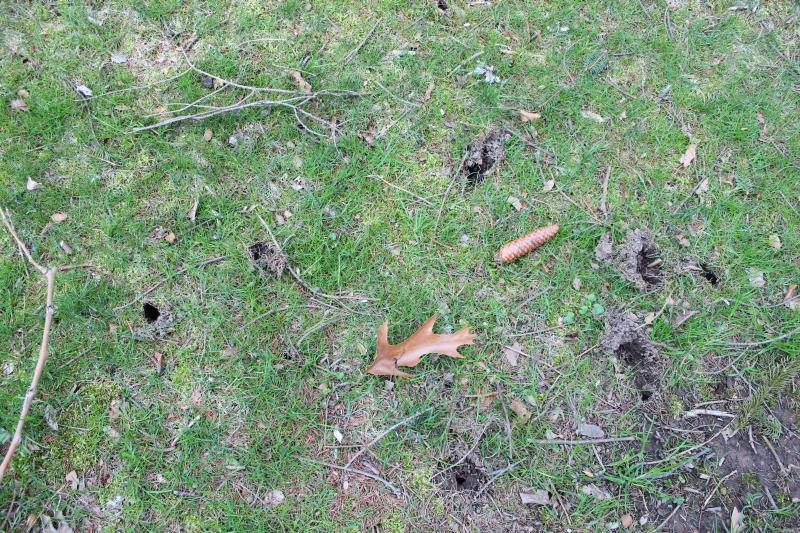
2) Look for cicadas under stones and slates. Some cicadas will burrow their way to the surface, but they hit a large stone or slate and can go no further.
If you find them in this situation, gently put the stone or slate back. They will usually find their way around the obstruction once the time is right.
One clue that a Magicicada nymph is not ready to emerge is its eyes are still white. Their eyes turn red/orange before emerging (a few retain a white/blue color).
3) Cicada holes are about the size of a dime. Cicadas preemptively dig holes to the surface and wait until the weather is nice enough for them to emerge. Sometimes you can see them down in the holes.
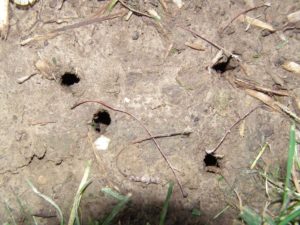
4) Cicadas form chimneys above their holes when the soil is moist or muddy. These chimneys might look like a simple golf ball-sized dome or a structure over six inches tall.
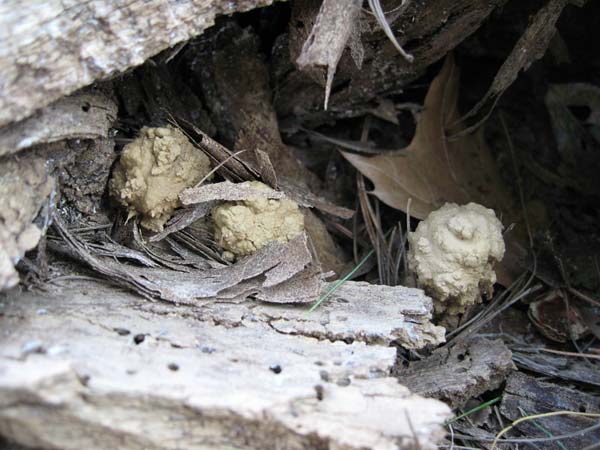
Photo by Roy Troutman.
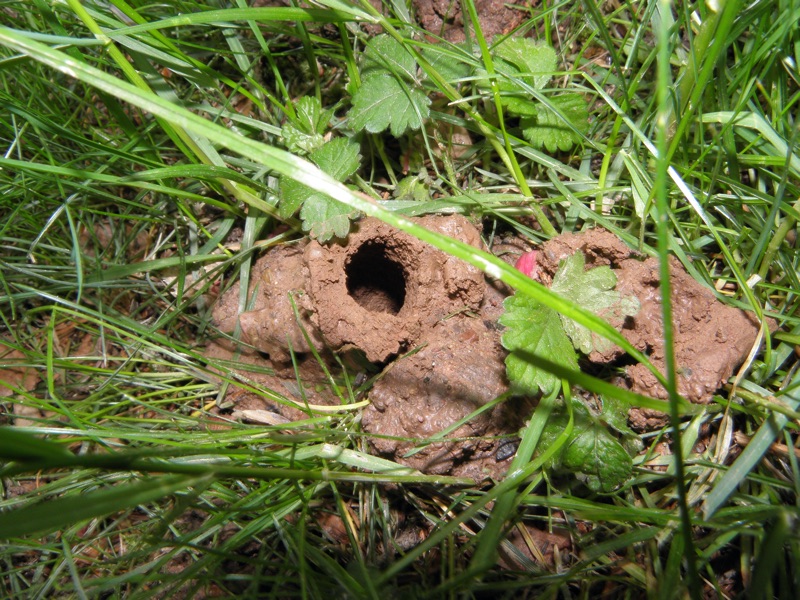
Periodical cicadas typically won’t emerge until their body temperature reaches approximately 65 degrees Fahrenheit (17-19.5 Celsius1). Their bodies are warmed by surrounding soil or warm water from rain. A good rule of thumb is, if the soil 8 inches(20 cm) deep is 65°F, the conditions are good that they might emerge.
And here’s how to tell if a nymph is ready to molt:
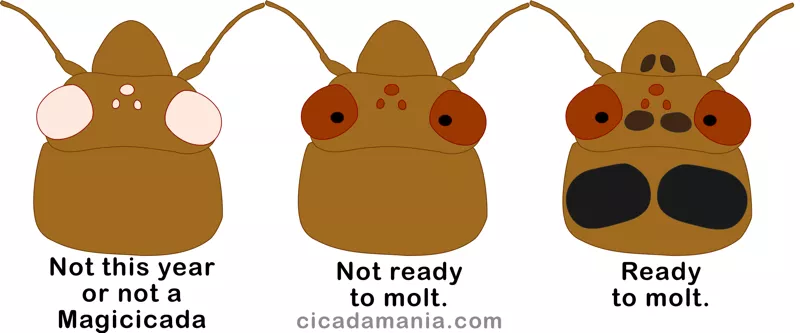
1Heath, J.E. 1968. Thermal synchronization of emergence in periodical “17-year” cicadas (Homoptera. Cicadidae, Magicicada). American Midland Naturalist 80:440—448.
95 replies on “Time to start looking for signs of periodical cicadas”
Typical cicada season in Prairie Village, KS (Kansas City) area this year. We have the cicada holes all over our backyard but this year we also have the cicada killer holes (a few) with the excavated dirt. I do t recall seeing these in the past. My 2 big dogs LOVE to eat cicadas. You’d think they were eating lobster! They don’t seem to mind the fact that they are wiggling and flapping their wings, they just gulp them down. So disgusting. And I agree with the writer that they can make your dogs sick if they ingest too many. We try to let them out before and after cicada party time (dusk) to minimize ingestion.
Horrific, but it is true, most dogs love to eat them.
Augusta, KS: We have tons of cicada skins on the willow tree in our back yard. There are also holes all over the ground under this tree. They are so loud and annoying!
Lancaster SC. We have cicadas which emerged end of July/early August. Light green in color.
I live in Dinwiddie,VA. We are not supposed to get Cicadas in our area however there are hundreds of holes in my yard. Will we see them?
I’m from Texas and if it is like here you will most defiantly see them. Ours are dying off now. But don’t be alarmed
Cicadas are still emerging everywhere and very loud except last week when temps were in low 50’s. Some areas l can step around them and others have so many l feel bad walking. My cat Alejandro enjoyed eating them until one grasped his nose. Am wondering why l see open holes in the ground and under leaves there are the mud mounds. Did l get it right that the mounds occur with wet soil and holes are in drier soil? I really enjoy them!
That’s correct. Seems like they build the mounts in wetter soil or near water. It probably keeps water from flowing into their holes.
Eldersburg, MD (Carroll County): Lots of exposed holes visible in bare areas of ground. Few cicadas around, but our area warms up later than other areas of MD. We are in a forested area, but are not impacted by any outbreak, yet.
I have seen lots in my Garden and other places in my house. Kindly let me know that what I can do to rid off from them.
Time. They’ll be gone in about 5 weeks. Fortunately, they don’t eat garden plants as a caterpillar or grasshopper would.
Have dug up nymphs, seen holes, and seen chimneys all spring gardening. Yesterday (May 9, 2021), took photo of two cicadas and one eco skeleton on one Corabell plant. Today a dozen are on the side of the house. Currently, experiencing Blackberry Winter–is that why no singing has been heard? Was told in 1970 that two Broods came to Knoxville the same year–but see no proof of that online–was anyone else told this? Back then cars slid on cicada covered roads like wet leaves, coves were completely covered with cicadas, and the sound was so loud you couldn’t sleep.
Only Brood X was out in 1970, with the chance of some early emerging stragglers from Brood XIV.
They are here in Langhorne Pa. Found lots of holes in my yard. I have several dogs, is it harmful to the dogs?
For dogs and other pets, it’s a yes and no answer. I’ve heard many stories of dogs happily gorging on cicadas with no ill effects. But I’ve also heard of pets choking on them (wings and ovipositors can be hard to swallow), illness from overeating (like someone who eats too much Thanksgiving dinner) like vomiting and malaise, and even one death attributed to a dog who ate cicadas that were soaked in pesticide. So be cautious and keep an eye on them.
They’re also mercury accumulators…
Yeah — don’t let the dog eat them.
I am starting to see holes all over my yard and I am in Langhorne Gable’s PA. My backyard gets covered and I do not want them how do I get rid of them?
You don’t get rid of them, you learn to love and embrace them.
I’m in Mission, Kansas City, and just the day before found hundreds of dime-sized holes in my thick grass and mulch beds! Some holes clearly had been squirreled — looking for a treat. Lots of trees in my yard and neighborhood so happy cicadas I hope! Chilly so haven’t heard them up and out yet. Does hole mean they have emerged or is there another clue?
Might be here to fore undocumented Brood X, or stragglers from Brood XIX. Or it could be something entirely different. Let us know!
Woohoo!!! I’ve got hundreds of the holes and chimneys in my yard just south of Annapolis Maryland. I’m very excited to see the emergence of Brood Ten. They’re just such fascinating creatures. I am signed up to help with the study to track the periodical cicada population with an app called “Cicada Safari” through Mount St Joseph University. It’s my understanding that the population is in decline and they think it may be due to global warming…. So please don’t needlessly kill them. Any additional information about their decline?
Global warming/climate change. That might take out some cicadas in the form of a catastrophic flood, or if the weather becomes chaotic — 80F one day, 40F the next — that’s not good for cicadas. But the impacts are not concrete.
The number one problem is not global warming — it’s urban and suburban sprawl. The U.S. population is rising by about 2 million people a year. As the population expands, new homes, roads, schools, stores & places to work are needed. With all that — let’s say each person needs about as much space as one tree. 2 million trees gone. Cicadas need host trees to survive. No trees, no cicadas. The trees that do survive end up being separated by roads and new construction which separates the Brood, and weakens it — the cicadas are divided and conquered. Yes, new trees get planted, but they’re rarely maples or oaks — garbage trees like sycamores or ornamentals get planted. And even when new trees are planted, there’s no guarantee the cicadas will switch to the new tree.
After population growth, the next problem is invasive species like emerald ash borers, which kill Ash trees, and Spotted Lanterflies which kill everything else. Global warming didn’t cause them — accidentally shipping them to the U.S. along with cargo did.
Yup they’re here in the DMV. was working in my back yard and found them. not in groups though, they’re spread out. I didn’t want to kill them so i covered them back up with dirt
Cicada holes and chimneys are common in Bedford County PA. St John St cemetery has a lot. Also in the woods at our house 2.5 miles south of Everett, Pa.
Yup THERE HERE !!!!! Harford County, MD hundreds of cicada holes in my yard along with the tons of chimney mounds of dirt !!!!! Finding more every day Ewwwwww Creepy Red eyed critters. Ladies get your hats ready they will get stuck in your hair!!!! I remember this from past experience yuck.
Mazie, they are gentle and uninterested in humans. How can they be, when they wake 17 years underground just to have a short chance at life for a couple of weeks? I have never had them get stuck in my hair or my clothes or anything and they don’t fly very fast so easy to avoid them.
my sentiments are with Mazie..eewww. i have a gigantic silver maple in the middle of my home in Montgomery County MD. They are everywhere…steps walkway railings window screens. I try to go out but I feel the anxiety each time I take a step. I am not a bug person and while all I hear is..they dont bite or sting that is no relief to a person with a real phobia. So many everywhere I try to step. My neighbors arent having this issue…just a few here or there.
Was just digging in a mulch bed to see how deep the mulch is because I plan to remove the entire bed and replace with grass. Every shallow shovelful had 5-6 cicada grubs. Totally disgusting! I’m in the Hudson valley, NY
That’s good news we’re going to be looking for them in Brooklyn when my grandkids get up here. We might pop up to sleepy Hollow and look for some more.
First year we have had SO Many holes in our backyard in South Carolina!! First thought was mole crickets, but after treating for them, to no avail-the holes returned and I definitely have noticed a Much Louder chorus of cicada’s in the evenings this past week. Our new puppy can hear them under the ground and is having a ball after the sun goes down jumping from hole to hole it’s like a game of whack a mole for this small pup, and I actually find the cicadas chorus soothing when it’s time to head to sleep. I’m still hoping it’s ciccada’s 100% ad not grubs or mole crickets that otherwise eat the lawns root system completely.
We have loads in the parks in Dayton- can’t even walk some of the trails without running into them- I took a picture into the woods and it’s all that you can see… it’s surreal and so wonderful!
Dayton, Ohio….just noticed TONS of these chimneys throughout my backyard when mowing yesterday…especially along the fence line where it’s more muddy and there’s not a lot of grass.
Just found hundreds mud mounds under trees in yard today in Hamilton, OH (near Cincinnati)…about 1-2 inches tall and sealed, not open like a crayfish chimney. I snapped them off and could see the dime-sized hole leading into the mound and then going underground. No cicada nymphs sited.
I read recently that Cicada Killer Wasps also burrow into the ground (for obvious reasons). Is it easy to tell the the two types of mounds apart? My yard is also full of molehills, unfortunately, so it sounds like I may see more dirt than grass this summer! (It sounds like I’m right between you and @RegencyJupiter03 – in Preble County.)
The Cicada Killer holes are bigger than Magicicada holes because they’re bigger and their prey are bigger (Neotibicen cicadas). Cicada Killer Wasps are typically active later in the season when the Neotibicen (green) cicadas are active. Cicada Killer holes are a little bit smaller than a bottle cap or quarter, while a Magicicada hole is about the size of a dime. Cicada Killer holes are also often on an angle, and you’ll see signs of external excavation, like soil that got kicked out in a single direction.
Thanks, Dan! That’s extremely helpful and helps me learn the proper terminology!
Dan, are the cicada killer bees harmful to humans and pets ??????
They’re not supposed to be. They’re interested in cicadas, not people or large animals. I’ve heard that if you squeeze them in your hand or step on them, they will sting in self-defense, but the sting is not so bad. A “2 on the insect sting pain index”.
Here are some videos:
This guy lets one sting him to see how bad it is:
This guy (Elias) has a “ball” of them in the palm of his hands:
Hi Dan, Do the cicada killer bees attack humans and pets?
Please read the Cicada Killer page.
Seeing hundreds of the little tunnels in my backyard in Northern Va
Saw dozens of mounds and holes in my yard and under shrubs today in southern Indiana. And then, crawling through the dirt, a cicada. Still white and moving very slowly
Just started seeing a multitude of holes in my backyard this morning in Bloomington, Indiana.
Dayton, Ohio
I have many holes in my backyard now. I found a nymph when I was moving a large flat rock.
4/13/21 – Pikesville, MD – rainy day yesterday, today I found lots of small cicada chimneys (still closed on top) in the lawn. They are little mounds or domes about 1-2 inches wide and high, made of wet mud. If you gently pick the mound off, there is a neat hole a little smaller than the size of a dime inside. I didn’t see the cicada, must have gone back down until time to come out in a few weeks.
cockeysville, MD. Same story as from Ruthanne above.
Same sightings here in Rockville MD
I am in Pikesville also and I saw places that have been dug up in my yard and I have many holes in the ground as well as a multitude of mud domes. I was ready to call an exterminator to find out what my problem is but I looked here first. Thank you. I thought that I had voles and I used up a canister of fox urine smelling stuff but my “problems” look like the cicada holes and domes and places where other animals dug up delicious cicadas. Wish I had looked here yesterday.
Dayton, Ohio. Oh my. I mowed our lawn after a couple days of rain and wow. Hundreds of mounds in our lawn on the side of the house. Apparently we are going to get bombarded when they emerge. Hundreds in a small area. I may have to leave for the summer 😂
My thoughts exactly! I’m finding the same thing. I told my husband I won’t be able to go outside. He thinks I’m goofy. I remember as a teenager we had them so bad we could not walk outside the house without getting bombarded from them. I’m not looking forward to this. I’m an outside girl, I don’t want to be stuck in the house.
I’m with you Stephanie ! Scared to death of the Brood X emergence!!
Agreed!! We get so many every year anyway I’m terrified of what’s coming. Yes I put insecticide in those yard holes around my giant tree. Will it help?? No idea.i just know i have childhood ptsd from this infestation. Grossed out just thinking about what’s coming.
I saw dozens of holes in a field in Gaithersburg, MD today! They were thumbtack-sized and part of small, hill-shaped mounds. Since they were so small, I was not sure if they were made by bees or cicadas.
After examining them more, they are ground bee burrows (saw a fuzzy bee looking out). But I did see cicada holes as well and saw a cicada nymph yesterday in the vicinity!
4/10/21. Seeing many holes in my yard now, Rockville, MD. Quite a few look tunneled out by an animal trying to dig up the nymph. Others are still a neat little hole. We found a couple nymphs at the bottom of a compost bin when turning it over.
Catonsville, Maryland – saw a few holes last week and many more holes this week, occasionally when planting or transplanting I have dug up a couple cicadas and then gently put them back.
Just started seeing holes in my mulch over the past week. I knew brood X was coming but I didn’t realize the holes were from the emerging cicadas. But, here they come…
I have them here in south Alabama! Seems they are migrating outside the projected map I found online. They put on quite a chorus this evening!
yeeeeeeeeeeeeeeeeeeeeeeeeeeeeeeeeeet
Prince William country VA
I have a Cicada stuck to my window screen this afternoon. I have been outside much today to look for holes.
I have lots of holes and cicadas in my yard. Bristol Virginia. Just haven’t really heard them here. I have heard them in other areas first part of spring. I have two that are on my porch on a post. They pretty much follow each other up and around post. I don’t see them move but every now and then when I look they’re in a different spot on the post!!! Why?
I don’t know why, but it’s been a slow to start annual season everywhere.
From Eastern NC: I have “tunnels” all over my lawn–in some areas they are 1-2″ apart.
The cicadas are Very Loud in my area.
I think they are destroying my lawn.
That doesn’t sound like cicadas. Might be Cicada Killer Wasps making burrows, though. Do you see giant wasps?
I just started seeing them in my backyard in Ridley Park, Pennsylvania, a southern suburb of Philadelphia. I found about 5 shells in 2 days and a few holes in the ground. I was creeped out so I swatted at the shells lol. I hope I didn’t do damage.
I have holes all in my yard. They have been thete for a while Started with a few. Now they are all over. But i haven’t seen any Cicadas yet.
I found seven holes here in Tucson with a nymph in one.
I found a cicada this morning, and had found a nymph under a stone last week! Located in North east AL
I have a bunch in my front yard I live in Baltimore (Towson) MD. They are just emerge yesterday but have had the wholes for a couple of weeks.
Eek I am afraid of cicadas I couldn’t even leave the house for school when brood X came in 2004 ( Ellicott city) approximately how many have you seen
I found one in my front yard, the shell was on a long blade of grass. I stooped down to see it, then i saw him sitting right below the shell.
I was amazed. I had never seen that before. He was green with clear wings. I brought him in the house to show my husband & he told me what it was & that it had just emerged & was drying his wings & would soon turn a different color.
I brought it and put it on my backyard tree. Now i can hear him every day at dusk. Now i hear others from a distance.
THIS WAS SUCH A TREAT FOR ME !!
I LIVE IN ABBEVILLE, LA.
SOUTHWEST LA. May 2016
Cool! If it was green and in Louisiana it is likely one of these species https://www.cicadamania.com/genera/usa.php?qs=LA&category=G&q=green#speciesresults
They are out and about here in Bostic, NC. Had to educate my son about them this morning when he heard them outside. lol
Here is a list of all the species in North Carolina https://www.cicadamania.com/genera/usa.php?category=A&q=&qs=NC&submit=SUBMIT
Here in Americus Kansas we have had them for weeks! We live on two acres but they seem to like the two trees closets to our house. Really have to dodge them going in or out of the house. So ready for them to move on.
I just seen 2 of them and it looks like there will be more coming up in our garden in rock hill sc
My yard is like walking on egg shells.the noise is terrible
I am a volunteer at Visitor Center at Perry Lake, Kansas and new to Kansas. I started hearing the “roar” and just looked up these little red eyed insects. I think they are in the millions singing to the females. It is like a wave of buzzing that goes from tree to tree in a crescent, then starts again and moves around the ring of trees again. I has been a new experience.
First starting appearing in Excelsior Springs, MO (north of Kansas City) about 10 days ago.
I live in Lakeland Tn also. They are very loud in the woods behind my house but i havent seen the first one yet. Plan to take my grand daughter on a short hike today to see if they have emerged yet.
Sorry….Pattilu is from southern Indiana.
Appearing by the thousands in our yard and woods. Saw their chimneys in early May in the woods, but didn’t know what they were until now. Started seeing the casings and live cicada’s by the thousands about 2 weeks ago. Now the trees and shrubs are covered with all stages…live, and in and out of shells. Creepy and hard to relax outside and I’m ready for this invasion to be over.
That was Carbondale, IL
Jackson County Carbondale/Murphysboro area …emergence started a few days ago
Hearing them in central Arkansas now.
Heard them outside last night in southwest Louisiana!
Lakeland TN has been invaded. The old carcasses are hanging from all vertical surfaces. It sounds like the roar of motors in my back yard!
I started hearing the flying saucer whirr of thousands of cicadas a few days ago here in Bolivar, TN. Yesterday I removed one empty casing from my front porch (creepy!), and four more this morning. It looks like there’s an adult one at the top of my front door lintel, and I just chased something out the door that came in with me a few minutes ago. Starting to feel a little uneasy here….
still here in NE. LA. Seems they are moving toward Arkansas. Love life in the country!
The Cicada’s are sounding off in N.E. Arkansas. Heard them for the first time today!
They invaded my space weeks ago. I love the visit but ready for them to go:) Clinton, MS
Cicadas are seen here in Graves county Kentucky already with wings drying and thousands of shells all over my trees and the leaves. I saw some in shells climbing yesterday that had just emerged.
New cicadas in my garden 5/15/2015 few miles west of Paducah Kentucky 42001
Red eyed cicadas are in northeast Louisiana , I have 30 on my porch and tons of wholes in the yard ..every stage from not hatchedbto hatched drying and then flying off in morning!!!
I had NO idea what this was but they are definitely here in NC. I pray I never see another one. Wishful thinking.
Our newly hatched cicadas here in MS are sounding like shirring flying saucers – loving it but eerie. Are these the cicadas you have posted here?